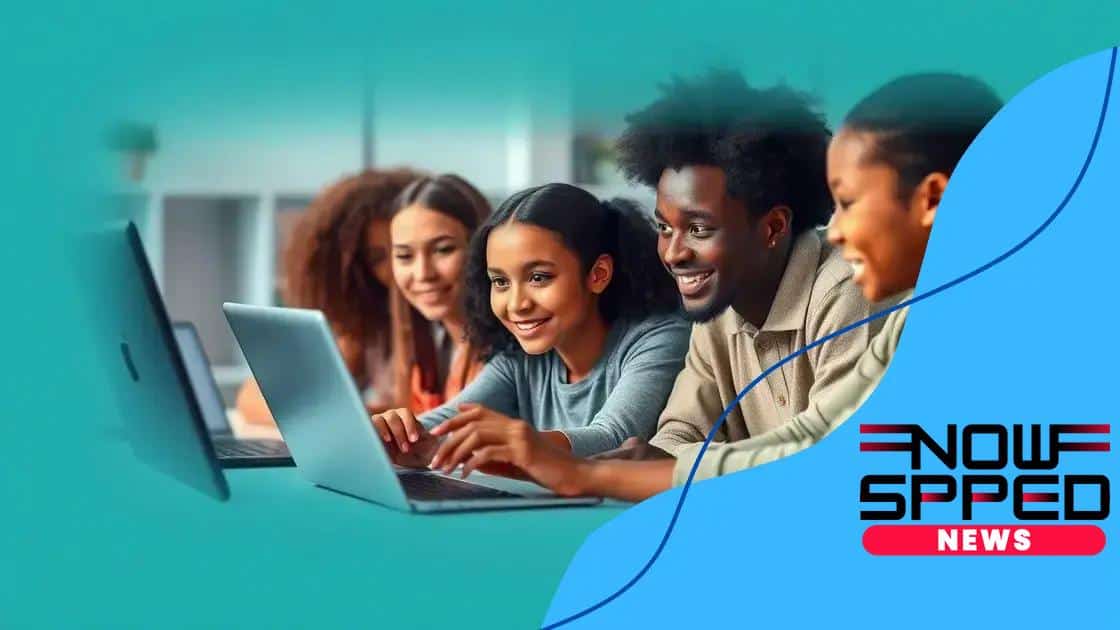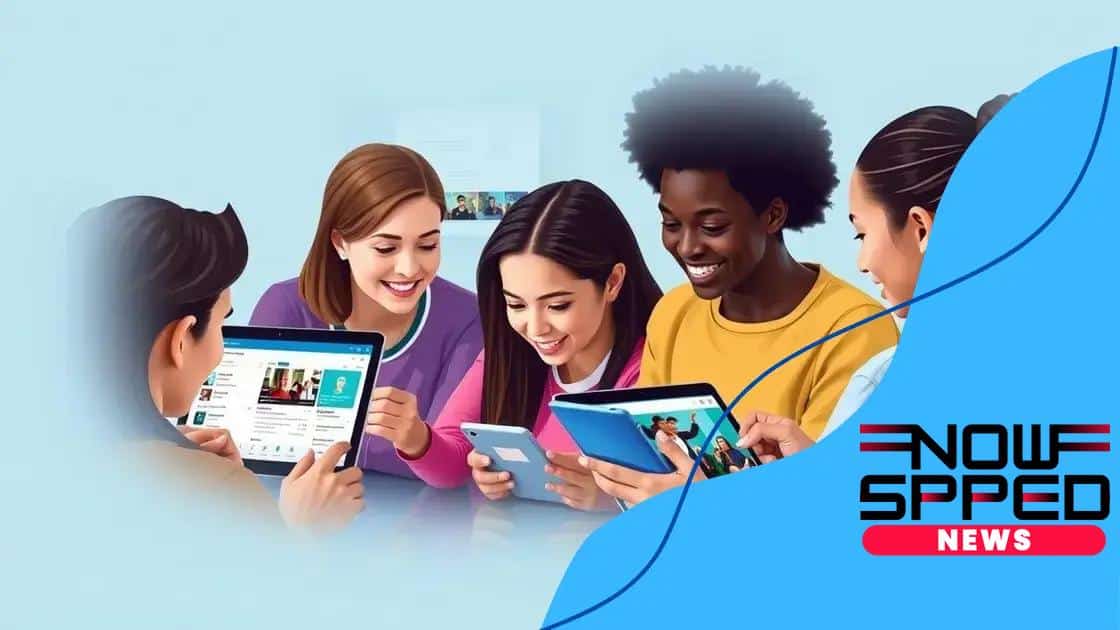Collaborative digital platforms for global learning

Collaborative digital platforms for global learning facilitate connections between students and educators worldwide, leveraging technologies like AI and VR to enhance educational experiences while addressing challenges such as access and engagement.
Collaborative digital platforms for global learning are transforming education by enabling interaction among students and educators worldwide. Have you ever wondered how these platforms can enhance your learning experience?
Understanding collaborative digital platforms
Understanding collaborative digital platforms is crucial for harnessing their full potential in education. These platforms allow students and educators to connect, share resources, and enhance learning experiences.
One key aspect is the variety of tools available on these platforms. Examples like video conferencing, file sharing, and discussion boards foster interactive education. These tools help overcome geographical barriers, allowing learners worldwide to engage in collaborative projects.
Features of Collaborative Platforms
Each platform has unique features that cater to different learning needs. Some of the most notable features include:
- Real-time collaboration: Users can work together on documents or projects efficiently.
- Resource sharing: Educators can distribute materials easily to all participants.
- Feedback tools: Instant feedback mechanisms help improve learning outcomes.
- Integration capabilities: Many platforms integrate with other educational tools for seamless experiences.
Another significant aspect is user accessibility. Platforms designed with users in mind promote inclusivity and support various learning styles. This ensures that every student has the opportunity to engage effectively.
Moreover, the community aspect of these platforms is vital. They create spaces where students can interact socially, leading to deeper learning relationships. Engaging with peers enables students to exchange ideas freely, further enhancing their educational journeys.
Security and Privacy Considerations
Finally, it’s essential to consider security on these platforms. Educators and learners should prioritize their privacy by choosing platforms that protect personal information and data. Familiarizing oneself with privacy policies can help ensure a safe digital learning environment.
Benefits of global learning through collaboration
The benefits of global learning through collaboration are profound and far-reaching. Engaging with diverse perspectives enriches the learning experience, allowing students to develop critical thinking skills and cultural awareness.
Collaboration among learners from different countries fosters a more inclusive environment. When students work together on projects, they not only share knowledge but also gain insights into each other’s cultures. This understanding promotes empathy and global citizenship.
Key Advantages of Global Learning
There are several key advantages to participating in global learning experiences:
- Enhanced Communication Skills: Collaborating with peers worldwide improves written and verbal communication skills.
- Access to Diverse Resources: Different backgrounds provide a wealth of resources and viewpoints that enrich learning.
- Problem-Solving Opportunities: Working in teams can lead to innovative solutions for real-world issues.
- Building Relationships: Students can form lasting friendships and networks across the globe.
Moreover, global collaboration encourages adaptability. Students learn to navigate various challenges, such as time zone differences and cultural nuances. These skills are essential in today’s interconnected world.
In addition, technology plays a significant role in facilitating these experiences. Online tools make it easy to connect and communicate effectively. Platforms designed for collaboration enable students to participate in meaningful exchanges regardless of location.
Real-World Applications
Real-world applications of global learning illustrate its effectiveness. For instance, students working on international projects can address global challenges like climate change and social inequality. By collaborating, they contribute to solutions that can make a real impact.
Ultimately, the shift towards global collaborative learning prepares students for a future where teamwork crosses borders. As they work together, they not only achieve academic goals but also become global citizens ready to tackle the challenges of tomorrow.
Key features of effective learning platforms

Key features of effective learning platforms play a vital role in enhancing the educational experience. Understanding these features can help educators and students maximize their usage of digital tools.
One of the most significant features is user-friendly design. A clean and intuitive interface allows learners to navigate the platform easily. When users can find what they need without frustration, they can focus more on learning.
Essential Features of Learning Platforms
Another important aspect is the availability of various interactive tools. Effective learning platforms typically include:
- Discussion forums: These allow students to engage in conversations, ask questions, and share insights.
- Multimedia resources: Access to videos, articles, and podcasts caters to different learning styles.
- Assessment tools: Quizzes and assignments help educators track progress and understand students’ needs.
- Customization options: Personalizing the learning experience keeps students engaged and motivated.
Integration with other software is also crucial. An effective platform can work seamlessly with tools like calendar apps and communication services. This flexibility enhances usability and fosters collaboration between users.
Moreover, support for mobile access ensures that learners can access materials anytime, anywhere. This convenience is especially important in today’s fast-paced world where learning needs to fit into various lifestyles.
Security and Privacy
Finally, security and privacy features are essential. Protecting user data builds trust among participants. Platforms must adhere to strict guidelines, ensuring that personal information remains safe. When students feel secure, they are more likely to engage fully.
Overall, the combination of these key features creates an effective learning environment. By incorporating user-friendly designs, interactivity, integration, and security, platforms can significantly enhance the learning experience for all users.
Challenges in using digital platforms for learning
Challenges in using digital platforms for learning can hinder the educational experience. Identifying these challenges is the first step in overcoming them.
One major challenge is technical issues. Students may face difficulties with connectivity, outdated devices, or software compatibility. These issues can disrupt the learning process and frustrate users. When technical glitches occur, they can lead to lost time and decreased motivation.
Common Challenges
Another obstacle is the digital divide. Not all students have equal access to technology and the internet. This disparity can create significant barriers to learning, especially for students from low-income families. Ensuring that all learners have the tools they need is crucial for inclusivity.
- Limited interaction: Some online platforms may not foster enough student-teacher interaction, which is vital for feedback and guidance.
- Time management: Students may struggle to stay organized without a structured classroom environment, leading to missed assignments.
- Engagement issues: It can be difficult for students to stay motivated and engaged when learning remotely.
Moreover, the need for self-discipline is heightened in digital learning environments. Students must manage their time effectively and remain focused without in-person supervision. This level of responsibility might be overwhelming for some learners.
Another concern is the potential for information overload. With so many resources available online, students can become overwhelmed by the amount of content they encounter. Learning to navigate and filter relevant information is a critical skill.
Addressing Challenges
Overcoming these challenges requires a collaborative effort from educators, students, and technology providers. Training sessions can help students and teachers navigate platforms more effectively. Additionally, providing resources for time management and study skills can support learners in adjusting to digital environments.
Ultimately, recognizing and addressing these challenges can lead to a more effective and fulfilling digital learning experience for everyone involved.
Future trends in global digital education
Future trends in global digital education are shaping how we learn and interact across borders. As technology evolves, so do the methods of teaching and learning.
One major trend is the rise of artificial intelligence in education. AI tools can help customize learning experiences by analyzing student performance and adapting lessons accordingly. This personalized approach allows students to learn at their own pace, which can improve engagement and retention.
Emerging Technologies
Another significant trend is the integration of virtual and augmented reality (VR and AR) in education. These technologies enable immersive learning experiences that can transport students to different environments or historical events without leaving their classrooms. For instance, students can explore ancient civilizations or conduct virtual science experiments in a safe setting.
- Increased accessibility: These technologies make it easier for students with disabilities to engage with learning materials.
- Enhanced collaboration: Students can work together in virtual spaces, collaborating on projects as if they were in the same room.
- Real-world applications: VR and AR can simulate real-world scenarios, making learning more relevant and practical.
Furthermore, there is a growing focus on lifelong learning. As job markets continue to change, the need for individuals to continuously update their skills is becoming essential. Online platforms are adapting by offering courses that cater to adult learners and professionals seeking to enhance their skills.
Another trend is the implementation of blockchain technology to secure educational records. By using blockchain, academic credentials can be verified easily, reducing fraud and streamlining the application process for students.
The Role of Global Collaboration
Collaboration between educational institutions worldwide is also on the rise. Global partnerships can provide students with unique opportunities for cross-cultural learning. With these collaborations, students can participate in international projects that foster understanding and teamwork among peers from different countries.
Ultimately, the future of global digital education is bright. By embracing these trends, we can create a more inclusive, engaging, and effective learning environment for students everywhere.
FAQ – Frequently Asked Questions about Collaborative Digital Platforms for Global Learning
What are collaborative digital platforms?
Collaborative digital platforms are online tools that allow students and educators to work together, share resources, and enhance learning experiences.
How does AI enhance digital learning?
AI personalizes learning experiences by analyzing student performance and adapting lessons to their needs, improving engagement and efficacy.
What role does VR play in education?
Virtual reality (VR) offers immersive experiences, transporting students to different environments, which enriches the learning process.
How can I ensure my students have equal access to technology?
To address the digital divide, provide resources like devices and internet access where possible, or utilize community programs that support educational technology.





